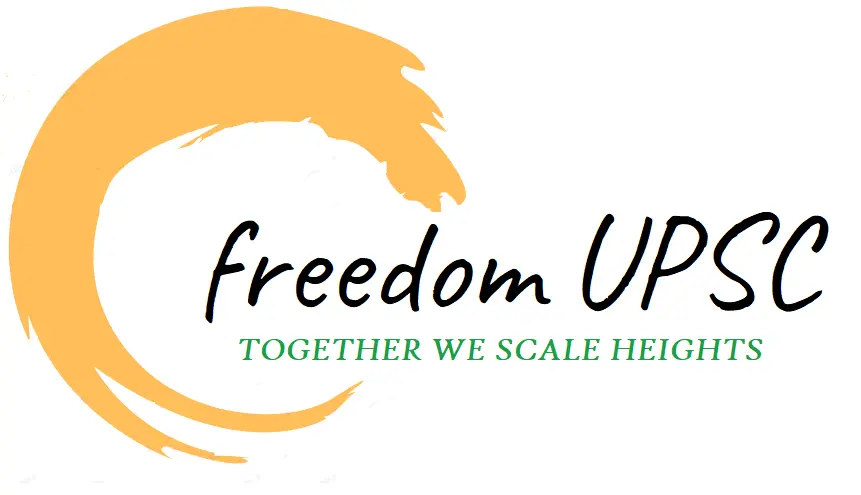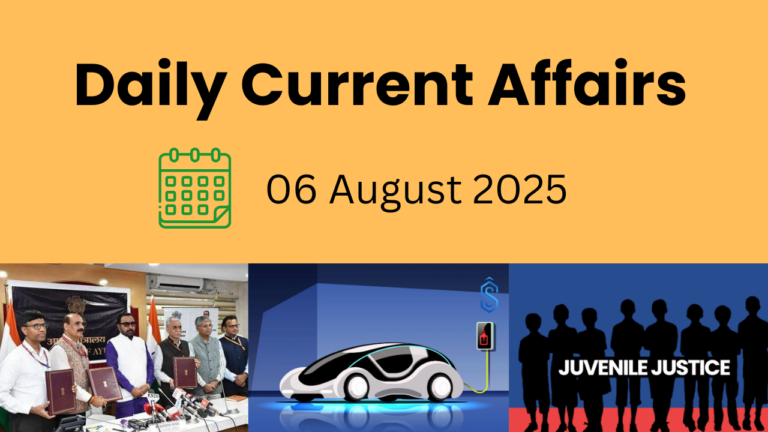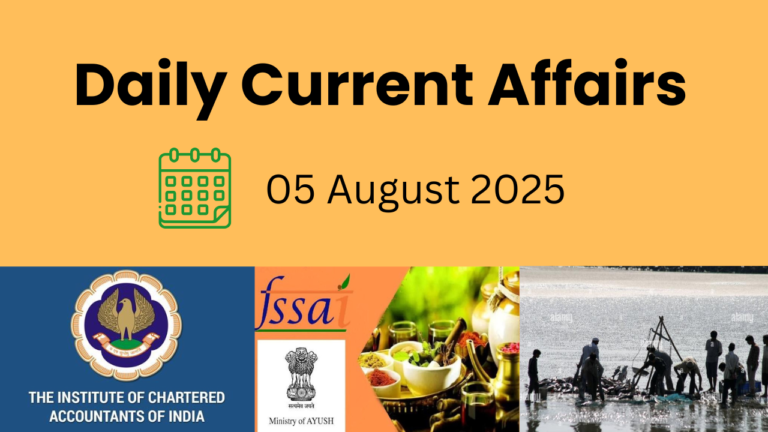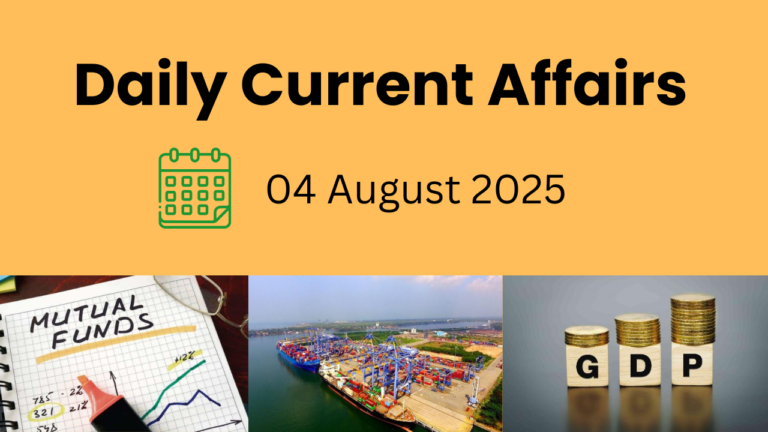1. World Audio Visual and Entertainment Summit (WAVES) 2025
Context: At the inaugural WAVES Summit 2025 held in Mumbai, the Prime Minister of India emphasized the creative economy as a vital force driving GDP growth, innovation, and inclusive development in the digital era.
Major Announcements:
Launch of the Indian Institute of Creative Technology (IICT)
- A National Centre of Excellence to be set up by the Ministry of Information & Broadcasting.
- Developed in partnership with FICCI and CII.
- Aims to upskill youth, promote media innovation, and nurture talent in:
- Animation
- Gaming
- Content creation
- Film and media technologies
Targeting a $50 Billion Market by 2029:
- WAVES 2025 envisions unlocking a $50 billion global market in media, entertainment, and content sectors, positioning India as a world leader in the creative economy.
Understanding the Creative Economy (Orange Economy):
“Creativity is the new currency of the digital age.”
The Creative Economy refers to industries that generate economic value through creativity, intellectual property (IP), and cultural expression.
Key Sectors:
- Cultural Industries: Music, cinema, theatre, literature, dance, crafts
- Creative Industries: Fashion, architecture, advertising, design
- Digital Sectors: Animation, VFX, gaming, OTT platforms, XR, YouTube, influencer content
Term Popularised by: John Howkins
“Orange Economy” coined by: Former Colombian President Iván Duque and Felipe Buitrago
Current Status of India’s Creative Economy (2025):
- $30 Billion contribution to GDP
- Employs around 8% of the workforce
- Creative exports exceed $11 Billion annually, led by film, music, and digital content
- India is among the top global players in fintech, mobile tech, and startups
India’s Untapped Potential in the Creative Sector:
Demographic Advantage:
- Over 65% of India’s population is below 35
- Youth are key drivers of gaming, design, content creation, and short videos
Digital Backbone:
- Second-largest internet user base globally
- Supported by initiatives like:
- Digital India
- BharatNet
- 5G rollout
Cultural Soft Power:
- Rich traditions in language, music, art, and mythology
- Exports like Bollywood, yoga, and Indian cuisine strengthen India’s global identity
Key Challenges Hindering Growth
| Challenge | Description |
| Lack of IP awareness | Weak enforcement of copyrights and royalties |
| Fragmented industry | Mostly informal, lacking formal structures |
| Skill Gaps | Outdated training methods in fast-evolving digital tools |
| Limited Funding | Inadequate access to grants and credit |
| Urban-centric Growth | Rural artists and talent remain underrepresented |
Way Forward:
- Expand IICT’s reach to Tier 2 & Tier 3 cities
- Strengthen IP laws and royalty systems
- Formalize creative sectors with MSME-style incentives
- Support rural artisans through digital platforms and e-commerce
- Update skilling programs to include XR, AI in art, and blockchain for IP
Conclusion: The WAVES 2025 Summit marks a turning point in recognizing creativity as capital. With policy support, digital tools, and youth participation, India’s creative economy can not only entertain the world—but also enrich its economy and empower its people.
2. World’s Largest Fusion Project Hits Major Milestone – With India’s Crucial Contribution
Context: The International Thermonuclear Experimental Reactor (ITER) has achieved a major construction milestone by completing its main magnet system, with India playing a vital role in this landmark scientific achievement.
What is ITER?
ITER (International Thermonuclear Experimental Reactor) is the world’s largest nuclear fusion project, under construction on a 180-hectare site in southern France. It is a collaborative megaproject involving 35 countries, including:
India, China, the United States, Russia, Japan, South Korea, and the European Union
Purpose:
To demonstrate the feasibility of nuclear fusion as a safe, large-scale, carbon-free energy source for the future.
Understanding Nuclear Fusion:
“Fusion is the process that powers the Sun and stars.”
- Fusion involves combining two light atomic nuclei (like deuterium and tritium) into a heavier nucleus, releasing immense energy.
- Unlike fission, fusion:
- Does NOT produce long-lived radioactive waste
- Is inherently safer (no meltdown risk)
- Is clean and sustainable
Objectives of ITER:
- To generate 500 MW of energy output from just 50 MW of input, achieving a tenfold energy gain.
- To demonstrate a self-sustaining “burning plasma”—a critical condition for viable fusion energy.
- To provide scientific data for future commercial fusion reactors (ITER will not generate electricity itself).
Funding and Cost Sharing:
| Region/Country | Contribution |
| European Union | 45% |
| India, China, Japan, Korea, Russia, US | ~9% each |
Note: All members receive equal access to research outputs and intellectual property rights.
Contributions by Member Countries:
| Country | Key Contributions |
| USA | Built the Central Solenoid, ITER’s most powerful magnet |
| Russia | Supplied the Poloidal Field magnet |
| Europe | Designed and produced four major Poloidal Field magnets |
| China | Supplied Correction Coil magnets and Poloidal Field magnets |
| Japan | Produced 43 km of Nb₃Sn superconducting strand |
| South Korea | Developed tooling systems for large component assembly |
| India | See details below ↓ |
India’s Pivotal Role in ITER:
India is a core member and has made critical technological contributions, including:
Cryostat and Cooling Systems:
- Designed and built the Cryostat — a 30-meter-tall vacuum chamber that houses the Tokamak.
- Installed cryolines and helium systems to cool magnets to -269°C (superconducting state).
Heating and Shielding:
- Delivered components for neutral beam heating, cooling water systems, and biological shielding structures.
What Milestone Was Just Reached?
ITER has successfully completed the assembly of its pulsed superconducting electromagnet system, a major part of the Tokamak’s magnetic confinement.
Key Function:
- This system will generate plasma by ionizing deuterium and tritium fuel.
- The plasma will be heated to over 150 million °C—10x hotter than the Sun’s core—to trigger fusion reactions.
Timeline and Future Outlook:
| Phase | Target Year |
| Scientific Operations Begin | 2034 |
| Deuterium-Tritium Fusion Tests | 2039 |
If Successful…
- Fusion energy could offer:
- Near-limitless clean power
- Zero carbon emissions
- No radioactive waste
- Could revolutionize the global energy landscape and help meet climate targets.
Did You Know?
- ITER’s central magnet is so powerful that it can lift an aircraft carrier.
- The cryostat built by India is the largest high-vacuum pressure chamber ever built.
- Fusion produces 4 million times more energy than burning coal, per unit mass of fuel.
Conclusion: The ITER milestone, achieved with significant Indian scientific and engineering input, represents a historic step toward achieving clean, sustainable fusion energy. As we move closer to 2034, the world watches as ITER becomes humanity’s biggest bet on the energy of the stars.
3. Vizhinjam International Seaport: India’s Gateway to Global Maritime Power
Context: Prime Minister Narendra Modi is set to inaugurate the Vizhinjam International Seaport, placing Kerala firmly on the global maritime map. This event marks a significant leap in India’s port infrastructure and trade capabilities.
Location & Overview:
Located in Vizhinjam, a serene coastal town near Thiruvananthapuram, Kerala, this port is set to be a game-changer in India’s maritime sector.
- India’s First: Dedicated transshipment port
- Semi-Automated Operations: The first of its kind in the country
- Project Cost: ₹8,900 crore
- PPP Model: Operated by Adani Group, with the Kerala Government holding a majority stake
Cutting-Edge Infrastructure & Technology:
- Deepest Breakwater in India: Nearly 3 km long, offering unmatched protection
- Natural Draft of 20 Metres: Ideal for ultra-large container vessels (ULCVs)
- Minimal Littoral Drift: Reduces dredging and maintenance costs
- AI-Powered Vessel Traffic Management System (VTMS): India’s first indigenously developed system, in collaboration with IIT Madras
- Automation at Its Best:
- Remotely operated ship-to-shore cranes
- Fully automated yard cranes
- Ensures faster, safer, and cost-efficient cargo handling
Strategic Importance:
- Location Advantage: Just 10 nautical miles from the busiest international East-West shipping route
- Transshipment Revolution: Currently, 75% of India’s transshipment is handled by foreign ports like Colombo, Singapore, and Dubai, leading to foreign exchange outflows
- Vizhinjam aims to reclaim this traffic, retaining economic value within the country
- Global Connectivity: Now part of direct shipping routes to Shanghai, Singapore, Busan, and other major ports
Future Expansion & Multi-Modal Connectivity:
Vizhinjam is envisioned as more than a port—it’s set to become a multi-modal logistics hub:
- Direct highway access via NH-66
- Kerala’s first cloverleaf interchange
- Upcoming rail link to integrate with the national railway network
- Plans for free trade warehousing zones, cold chains, and inland container depots to boost regional trade
Extra Insights & Global Comparison:
- Transshipment Defined: It refers to transferring cargo from one ship to another—crucial for countries with global trade ambitions.
- Why This Matters: Ports like Singapore and Dubai grew into financial powerhouses by dominating transshipment. Vizhinjam aims to replicate this model in India.
- Environmental Edge: The port’s naturally deep waters reduce ecological disruption and save on costly dredging operations.
Key Takeaways:
- First-of-its-kind project in India with world-class features
- Will enhance India’s competitiveness in global maritime trade
- A transformational asset for Kerala’s economy and employment
- Supports Make in India and Atmanirbhar Bharat by boosting local infrastructure
4. Ukraine’s Critical Minerals: Powering the Future of Green Tech and Global Security
Context: In a major strategic shift, the United States and Ukraine have signed a critical minerals partnership. The agreement gives the U.S. preferential access to Ukraine’s rich mineral deposits and establishes a joint investment fund to support Ukraine’s post-war reconstruction and energy independence.
What Are Critical Minerals and Rare Earth Elements?
Critical Minerals are naturally occurring materials essential to modern technology, clean energy, and national defense. Their supply chains are highly vulnerable due to geopolitical risks and limited global sources.
Rare Earth Elements (REEs) — a subgroup of 17 metals — are indispensable for:
- Electric vehicle (EV) motors
- Smartphones
- Missile guidance systems
- Wind turbines
- Military and aerospace technology
According to the U.S. Geological Survey (USGS), 50 minerals, including lithium, cobalt, nickel, and rare earths, are considered critical due to their:
- Non-substitutability
- High economic importance
- Supply vulnerability
Ukraine’s Hidden Treasure Trove:
Ukraine holds immense untapped potential in critical mineral reserves, making it a vital resource partner for the West.
Mineral Riches at a Glance:
- 22 of the 34 EU-classified critical minerals are found in Ukraine.
- Rare Earth Elements: Includes neodymium, cerium, lanthanum, erbium, scandium, and yttrium.
- Lithium: Estimated reserves of 500,000 metric tonnes, among the largest in Europe.
- Nickel, cobalt, manganese: Key for EV batteries and energy storage.
- Graphite: Ukraine holds about 20% of global reserves, vital for nuclear reactors and battery anodes.
- Titanium: Used in aircraft, satellites, defense, and high-performance materials.
Key Locations:
- Lithium: Central, eastern, and southeastern Ukraine
- Titanium: Northwestern and central Ukraine
- Graphite and REEs: Scattered across central and eastern regions
Strategic Importance: Countering China’s Dominance:
China currently controls over 80% of global rare earth production, raising major concerns about monopoly-driven pricing and supply chain risks.
Ukraine’s vast resources offer:
- A secure alternative for the EU and U.S.
- A chance to diversify the global critical minerals supply
- Strategic leverage for Ukraine’s economic revival and geopolitical relevance
The Road Ahead: Opportunity & Challenge
- Investment Potential: With Western backing, Ukraine could become a European mining hub post-conflict.
- Reconstruction Synergy: Mineral extraction can fund rebuilding, create jobs, and boost exports.
- Environmental Concerns: Sustainable mining practices will be key to long-term viability and global support.
Summary:
| Mineral | Use | Ukraine’s Strength |
| Lithium | EVs, energy storage | One of Europe’s largest reserves |
| Graphite | Batteries, nuclear reactors | ~20% of global resources |
| Rare Earths | Electronics, defense, green tech | Multiple types available across the country |
| Titanium | Aerospace, defense, industrial alloys | High-grade, strategically located |
5. Egypt in the Spotlight: Strengthening Strategic Ties with India
Context: India and Egypt have taken a significant step in enhancing their bilateral relationship, particularly in the field of counter-terrorism. The two nations convened the 4th Joint Working Group Meeting, reaffirming their commitment to cooperate on security, intelligence sharing, and regional stability.
Egypt: A Strategic Crossroads of Continents
Geopolitical Location:
Egypt is uniquely positioned at the northeastern edge of Africa, acting as a crucial link between Africa, Asia, and Europe through the Suez Canal—a globally vital maritime trade route.
- Capital: Cairo, one of the largest cities in Africa and the Arab world
- Neighbouring Countries:
- Libya to the west
- Sudan to the south
- Israel to the northeast
- Bordering Water Bodies:
- Mediterranean Sea to the north
- Red Sea and Gulf of Aqaba to the east
Fact: The Suez Canal, located in northeastern Egypt, handles over 10% of global maritime trade, making Egypt a critical player in global logistics.
Key Geographical Features of Egypt:
Terrain and Natural Landmarks:
- Major Mountain Ranges:
- Red Sea Hills (Eastern Desert)
- Sinai Mountains (Sinai Peninsula)
- Highest Peak:
- Mount Catherine (2,642 m), located in the Sinai Peninsula, is Egypt’s tallest mountain and a revered pilgrimage site.
- Major River:
- The Nile River, the longest river in the world, flows northward through Egypt, playing a vital role in agriculture, economy, and ancient civilization.
- Deserts:
- Western Desert (Al-Ṣaḥrāʾ al-Gharbiyyah): Covers about two-thirds of the country.
- Eastern Desert (Al-Ṣaḥrāʾ al-Sharqiyyah): Lies between the Nile River and the Red Sea, rich in mineral resources.
Why Egypt Matters Today:
- Strategic Location: Controls the Suez Canal, crucial for European–Asian trade.
- Cultural Influence: A historic hub of Arab culture, Islamic scholarship, and ancient history.
- Diplomatic Role: A key mediator in Middle Eastern peace processes and African Union initiatives.
- Economic Hub: Investing in mega projects like the New Administrative Capital and clean energy, including one of the world’s largest solar farms in Benban.
6. Antibiotic Access Crisis Against CRGN Infections
Context: A recent study published in The Lancet Infectious Diseases has raised alarm bells over the severe lack of access to effective antibiotics for carbapenem-resistant Gram-negative (CRGN) infections in India. The study reveals that only 7.8% of affected patients in India received appropriate treatment, underscoring a critical gap in managing multi-drug resistant infections.
Key Findings: Antibiotic Access and CRGN Infections
Limited Access to Effective Antibiotics:
- The study examined 1.5 million CRGN cases across eight low- and middle-income countries (LMICs) in 2019.
- In India alone, out of nearly 10 lakh CRGN infections, fewer than 1 lakh patients received correct antibiotic treatment.
- Only 7.8% of Indian patients were treated appropriately—slightly above the 6.9% average for the studied LMICs (India, Bangladesh, Brazil, Egypt, Kenya, Mexico, Pakistan, and South Africa).
- This treatment gap is estimated to have resulted in approximately 3.5 lakh deaths in India.
Barriers to Proper Treatment:
The study identified multiple obstacles:
- Insufficient diagnostic infrastructure
- Lack of standardized treatment protocols
- Poor antibiotic availability and affordability
Recommendations by the Study:
- A dual approach is essential:
- Preserve existing antibiotics through responsible usage (antibiotic stewardship).
- Ensure access to effective treatments for all patients in need.
- Regulatory reforms, improved diagnostics, and supply chain interventions are vital.
- Urges countries to bridge the access gap and strengthen healthcare capacity to combat resistance.
Understanding CRGN: A Public Health Threat
What is CRGN?
Carbapenem-Resistant Gram-Negative (CRGN) bacteria are pathogens that have developed resistance to carbapenem antibiotics, which are often the last resort for treating severe, multi-drug resistant infections.
Mechanism of Resistance
- CRGN bacteria produce carbapenemase enzymes, which neutralize antibiotics, rendering treatment ineffective.
- Resistance spreads via horizontal gene transfer, rapidly affecting hospital and community settings.
Examples of CRGN Pathogens:
- Escherichia coli
- Klebsiella pneumoniae
- Pseudomonas aeruginosa
These bacteria can cause:
- Pneumonia
- Bloodstream infections (sepsis)
- Urinary tract infections (UTIs)
Why CRGN is Dangerous:
- Infections are difficult to treat, with limited alternative options.
- Linked to:
- High mortality
- Prolonged hospitalizations
- Escalating healthcare costs
- Global health agencies, including WHO, list CRGN as a top priority pathogen.
Gram Staining: Classifying Bacteria
Basics of Bacteria:
- Bacteria are unicellular prokaryotes, lacking a true nucleus.
- Key components: cell wall, DNA, cytoplasm, flagella, ribosomes, etc.
- Classified into:
- Gram-positive bacteria
- Gram-negative bacteria
The Gram Staining Technique:
A widely used method to differentiate bacteria based on cell wall structure:
- Gram-positive bacteria: Have a thick peptidoglycan wall; stain violet.
- Gram-negative bacteria: Have a thin wall with an outer membrane; stain red or pink due to the loss of crystal violet during decolorization.
Conclusion: An Urgent Call to Action
The fight against antimicrobial resistance (AMR) hinges on:
- Strengthening global healthcare systems
- Ensuring equitable access to effective antibiotics
- Investing in research, diagnostics, and drug development




